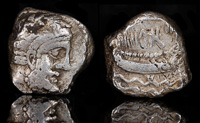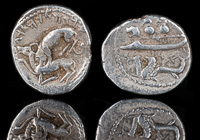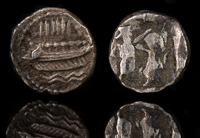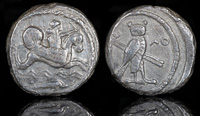Phoenicia
Tyre is founded according to Herodotus. Some archeological data backs this up.
Pharaoh Pepi I of Egypt mentions Byblos in texts, reflecting ongoing trade relations.
Egyptian Pharaoh Senusret III continues relations with Byblos, with inscriptions confirming Egyptian influence in the city.
Thutmose III of Egypt takes Arados on his Syrian campaign.
Sidon is part of the Egyptian empire and is ruled by Zimredda.
Tyre is under Egyptian control.
Byblos appears in the Amarna Letters, diplomatic correspondences from this period, reflecting its role in the regional politics of the Late Bronze Age.
Tyre achieves independence from Egypt.
Ahiram (Ahirom), a Phoenician king of Byblos, is buried in a sarcophagus with one of the earliest known inscriptions in the Phoenician alphabet.
The Assyrian king Tiglath-pileser I records that he sailed in boats of Arados.
Hiram I becomes King of Tyre, leading the city to great prosperity.
Presumed death of Hiram I of Tyre.
The neo-assyrian king Shalmaneser V besieges Tyre.
King Abdi-Milkutti of Sidon rises up against the Assyrians.
Ashurbanipal of Assyria forces Arados under King Yakinlu to submit and give one of his daughters to his harem.
Eshmunazar I founds a dynasty in Sidon.
The siege of Tyre by Nebuchadnezzar II is given up in failure.
Death of Eshmunazar I of Sidon. Tabnit I becomes king.
Death of Tabnit I, whose sarcophagus was found with his body perfectly intact in 1887. Eshmunazar II becomes King of Sidon.
Premature death of Eshmunazar II, whose sarcophagus today is displayed in the Louvre. His son Bodashtart becomes King of Sidon.
Death of Bodashtart of Sidon. He had restored the Temple of Eshmun. His heir Yatonmilk becomes king.
Death of Yatonmilk of Sidon. Anysos becomes king.
September 26
Aegina plays a significant role in the Greek naval victory against the Persian Empire in the Battle of Salamis. Byblos, Arados, Tyre, Halikarnassos under Artemisia, Kos, and Sidon support Darius. Chalkis and Kythnos support the Greek effort. Alexander I serves as a peace negotiator on behalf of the Persians.
Sidon rises in rebellion against Persian rule under Artaxerxes II. The rebellion is initially successful, but Artaxerxes III eventually suppresses it after Sidon is besieged and captured. The city’s destruction and subsequent punishment mark a decline in Sidon’s prominence.
Approximate date of the founding of Caesaria Maritima by Straton I of Sidon. The original name is Straton’s Tower.
Another major rebellion erupts in Sidon against Persian control, led by Tennes (Tabnit), the king of Sidon, who initially receives support from Egypt and Cyprus. However, Artaxerxes III besieges Sidon and defeats the rebels. The Persians destroy Sidon in retaliation, leading to a massacre where thousands of Sidonians die.
Artaxerxes III Okhos sends his satraps Belesys and Mazaios to retake Sidon, Tyre, and Byblos. The Persians are defeated by the Phoenicians, supported by Nektanebo II and Mentor of Rhodes.
Autophradates leads the Aegean fleet of Persia under the supreme command of Memnon of Rhodes. Azemilkos of Tyre accompanies him.
Sidon, Byblos, and Arados under Gerostratos submit to Alexander the Great as he travels through Phoenicia.
Alexander the Great completes the Siege of Tyre. 6000 soldiers are killed in the city, 2000 Tyrians are crucified on the beach, and 30,000 are sold into slavery. Their leader Azemilkos is pardoned but deposed. Gerostratos of Arados presumably plays a part.
Alexander III deposes Straton as king of Sidon.
Androkles of Amathos, Pnytagoras of Salamis, and Pasikrates of Kourion join Alexander the Great at the Siege of Tyre, where their qinqueremes are destroyed.
The flagships of Pnytagoras of Salamis, Androkles of Amathos, and Pasikrates of Kourion are destroyed while anchored in the harbor of Tyre.
Mallos gives ships to aid Alexander III in the Siege of Tyre.
Antigonos I Monophthalmos Declaration of Tyre grants autonomy to all Greek cities. While its effects weren’t the same everywhere, it allowed Delos to regain control of its Temple to Apollo from Athens.
Antigonos Monophthalmos besieges Tyre.
Tyre is taken by Antigonos Monophthalmos after a year.
Tyre becomes a republic.
258 BCE
Antiochos II Theos of the Seleukid Empire fights the Second Syrian War against Ptolemy II Philadelphos of Egypt. Arados takes the side of Antiochos.
Hannibal escapes to Tyre from the Romans.
Alexander Balas gives Tyre the right to asylum.
Tyre adopts its own calendar.
Marc Antony comes to Arados in search of money and is vigorously opposed.
Sidon shelters many Jews during the revolts and saves them from being killed.



